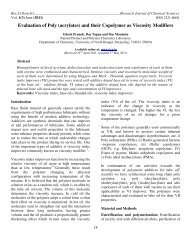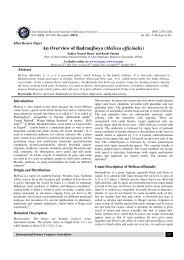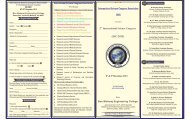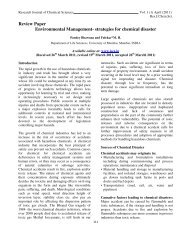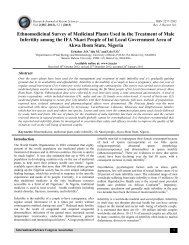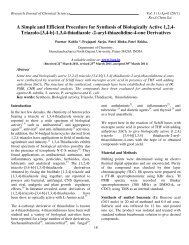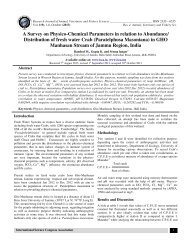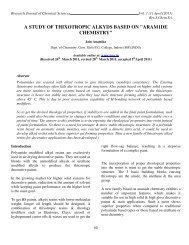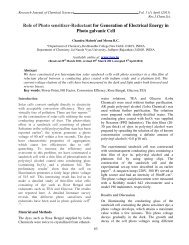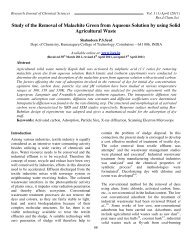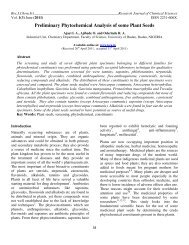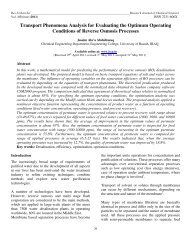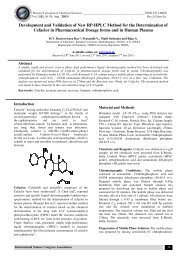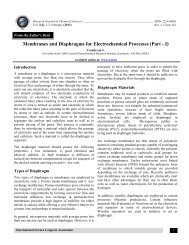Design and development of fast Melting Tablets of ... - ISCA
Design and development of fast Melting Tablets of ... - ISCA
Design and development of fast Melting Tablets of ... - ISCA
Create successful ePaper yourself
Turn your PDF publications into a flip-book with our unique Google optimized e-Paper software.
Research Journal <strong>of</strong> Chemical Sciences Vol. 1 (1) April (2011)<br />
Res.J.Chem.Sci.<br />
disintegrants are polymers which are cross linked Compression force was kept constant for all<br />
<strong>and</strong> have the capability to swell in contact with formulations.<br />
aqueous medium. As the superdisintegrants swell<br />
they increase the diameter <strong>of</strong> the tablet <strong>and</strong> help in Evaluation <strong>of</strong> powder blend<br />
overcoming the binding force <strong>of</strong> the binder <strong>and</strong> the Angle <strong>of</strong> repose: The angle <strong>of</strong> repose <strong>of</strong> powder<br />
compaction force used in the formulation <strong>of</strong> the blend was determined by the funnel method 5 .<br />
tablet which held together the granules.<br />
Results are shown in table 3.<br />
In this work we have tried to formulate a mouth<br />
melting dosage form <strong>of</strong> Terbutaline Sulphate by<br />
varying the concentration <strong>of</strong> superdisintegrants<br />
[Crospovidone (CP) <strong>and</strong> Croscarmellose Sodium<br />
(CCS)] so as to know at which concentration it is<br />
most effective.<br />
Materials <strong>and</strong> Methods<br />
Terbutaline Sulphate was obtained as a gift sample<br />
from IPCA laboratories Pvt. Ltd. Ratlam, India.<br />
Croscarmellose Sodium <strong>and</strong> Crospovidone were<br />
obtained as gift samples from Syncom labs. Pvt.<br />
Ltd. All other chemicals were <strong>of</strong> analytical grade.<br />
Optimisation <strong>of</strong> Superdisintegrant<br />
concentration: Before the formulation <strong>of</strong> Fast<br />
melting tablet the amount <strong>of</strong> CP <strong>and</strong> CCS was<br />
optimised. Various batches <strong>of</strong> tablets were<br />
prepared containing blend <strong>of</strong> Mannitol <strong>and</strong> CP or<br />
CCS in varying concentration. The weight <strong>of</strong> tablet<br />
was fixed at 150 mg. All the tablets were prepared<br />
using direct compression method. All the<br />
formulation variables were held constant in order<br />
to optimise the amount <strong>of</strong> CP <strong>and</strong> CCS. The data<br />
displayed in table 1.<br />
Preparation <strong>of</strong> <strong>fast</strong> melting tablets: Fast<br />
melting tablets <strong>of</strong> batch size five hundred (500)<br />
was prepared by direct compression process using<br />
different proportions <strong>of</strong> Mannitol <strong>and</strong> CP or CCS.<br />
Mannitol, CP or CCS to be used in each batch <strong>and</strong><br />
Terbutaline Sulphate were mixed thoroughly for 15<br />
minutes in a porcelain mortar <strong>and</strong> passed through<br />
sieve # 60. This blend was mixed with aerosil, pregelatinised<br />
starch, <strong>and</strong> magnesium separate<br />
(magnesium separate was added in last as it is<br />
hydrophobic in nature <strong>and</strong> affects tablet<br />
disintegration) for five minutes <strong>and</strong> again the entire<br />
blend was passed through sieve # 80. Powder<br />
blend was evaluated for bulk density, tapped<br />
density, Carr’s index <strong>and</strong> Hauser’s ratio.<br />
Compression <strong>of</strong> tablets was done on single punch<br />
machine (Scientech) using 7 mm flat punch.<br />
106 107<br />
Bulk density <strong>and</strong> Tapped density: Powder bulk<br />
density <strong>and</strong> tapped density were determined using<br />
the usual process 5 . Results are displayed in table 3<br />
Carr’s Index: Carr’s Index was determined by<br />
using the under mentioned formula 5 .<br />
Carr’s Index (%) = [(TD-BD) x100]/TD<br />
Where<br />
TD- tapped density<br />
BD- bulk density<br />
table 3 shows results<br />
Hausner’s Ratio: Hausner’s ratio was determined<br />
by the underlying formula 5 .<br />
Where<br />
H = P T /P B<br />
H denotes Hausner’s ratio<br />
P T denotes tapped density<br />
<strong>and</strong> P B denotes bulk density<br />
Results are shown in table 3<br />
Evaluation <strong>of</strong> Tablet Characteristics<br />
Hardness test <strong>and</strong> Friability: Hardness <strong>of</strong> tablet<br />
was evaluated using Monsanto hardness tester 6 .<br />
Friability <strong>of</strong> tablets was tested by Roche’s<br />
friabilator 6 .<br />
Drug Content: Drug content <strong>of</strong> prepared tablet <strong>of</strong><br />
each batch <strong>of</strong> the formulation was determined 8 .<br />
From each batch 20 tablets were taken, weighted<br />
<strong>and</strong> finely grounded. An amount <strong>of</strong> powder<br />
equivalent to 5 mg <strong>of</strong> powder was accurately<br />
weighted <strong>and</strong> dissolved in 6.8 phosphate buffer.<br />
The resulting solution was suitably diluted <strong>and</strong><br />
analysed on UV spectrophotometer Shimadzu 1601<br />
at 284 nm.<br />
Weight Variation: Weight variation 6 was<br />
determined by taking 20 tablets using electronic<br />
balance (Contech).



